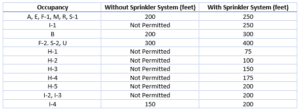Travel Distance Advantages of Automatic Fire Sprinkler Systems
We have all been there when checking into our hotel room for the night. The elevator drops you off on your floor and then you walk a country mile and finally arrive at your room. As I made that journey to my room, with all my belongings being dragged behind me, I have often thought, “I would hate to make this trip during an emergency situation.” As a former Authority Having Jurisdiction (AHJ), I have reviewed many building plans that struggle to achieve safe travel distances within in the design. The spaces being designed would be attractive for sure but being able to safely exit within the prescribed travel distances allowances would be a challenge.
This is another huge advantage of an automatic fire sprinkler system. When they are installed, you are permitted longer travel distances within the design. Coupled with a few passive fire protection systems, this is what allows that country mile walk in a hotel or an apartment building. Before jumping into the specified code sections regarding travel distances, let’s talk briefly about the concept of travel distance.
The International Building Code (IBC) is concerned with the means of egress being located so that the distance of travel from any occupied point in the building to an exit is not excessive. The IBC establishes maximum allowable distances to exits from any occupiable point of the building. This distance is referred to as the travel distance. Travel distance is the length that a building occupant must travel from the most remote occupiable portion of the building to the door of an interior exit stairway or ramp, an exit passageway, or a horizontal exit; to an exterior egress stairway or exterior egress ramp; or to an exterior exit door located at the level of exit discharge. The travel distance limit is only imposed to the nearest exit component.

It’s important to note when talking about hazards in this discussion specifically refers to the relative degree of hazard between different occupancy classifications. The IBC states in Section 1017.2 that the travel distance to an exit may not exceed the distances found in Table 1017.2.

As you can see for most moderate hazard occupancies, the travel limitation is 200 ft. Notice what happens when an automatic fire sprinkler system is installed, you are permitted an additional 50 ft of travel distance. The travel limitations vary from these distances in occupancies considered as low hazard and high hazard. Fully sprinklered business occupancies are permitted to have travel distances of up to 300 ft. In low hazard factories and warehouses, as well as utility buildings, the travel distances increase from 300 ft to 400 ft. Travel distances in hazard occupancies vary from a low 75 ft (H-1) to a high 200 ft (H-5) in buildings when protected by automatic fire sprinkler systems. Similarly, in I-2, I-3, and I-4 occupancies a travel distance up to 200 ft in protected buildings, as to where in I-1 occupancies a travel distance of up to 25 ft is permitted.
What about F-1 and S-1 occupancies? These are common occupancies that are seen in the design world. Section 1017.2.2 addresses those two occupancies. The general travel distance limitation of 250 ft in fully sprinkler protected moderate hazard factory and storage buildings can be increased where three conditions are met. Those conditions are: 1. The portion of the building classified as Group F-1 or S-1 is limited to one story in height. 2. The minimum height from the finished floor to the bottom of ceiling or roof slab or deck is 24 feet. 3. The building is equipped throughout with an automatic sprinkler system in accordance with Section 903.3.1.1. A travel distance of up to 400 ft is allowed when all three conditions are met. Incorporating these travel distances advantages in your next designs could help meet the needs of customer and meet the requirements of the building code.
